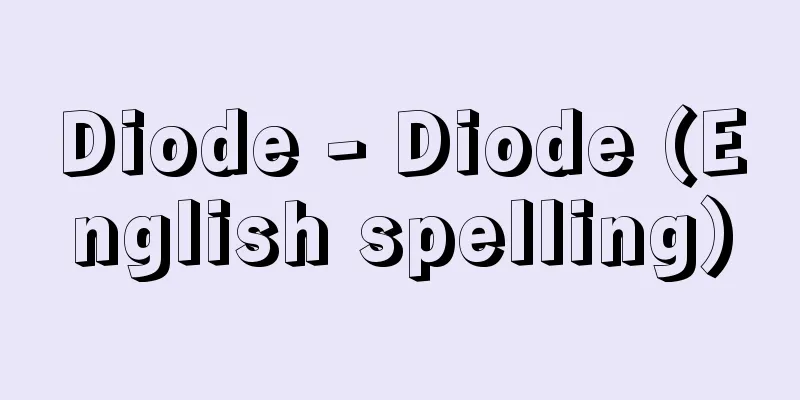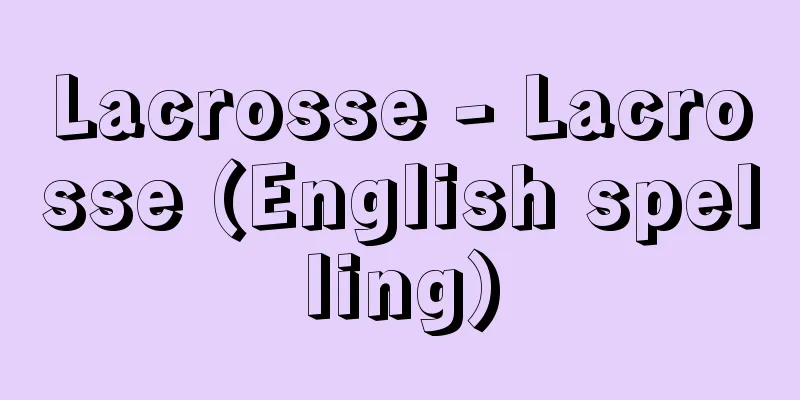Diode - Diode (English spelling)

|
A general term for a two-terminal solid-state device with rectifying properties. In the vacuum tube era, it referred to a diode tube. Rectifying properties refer to the ability to distinguish between a forward direction, in which current flows easily, and a reverse direction, in which current hardly flows, depending on the direction of the voltage applied to the two terminals. However, today it is used in many different ways, not just for rectification. It has long been known that rectification occurs when metals are in contact with semiconductors, and this has been put to practical use in the form of selenium rectifiers and cuprous oxide rectifiers. There have also been crystal detectors used to detect radio waves. Various theories have been proposed as to the mechanism of rectification in these devices (Frenkel, Wilson, and Nordheim in 1932, Schottky in 1939, Mott in 1940, etc.). However, at the time, the crystals were polycrystalline and the purity of the materials was low, so theoretical verification was not possible. It was not until after World War II that full-scale development began along with the transistor. Currently, the diodes in use are junction diodes, which follow Shockley's pn junction theory from 1949, and Schottky diodes, which follow Schottky's theory. However, various diodes that are not included in the rectification category have also appeared, such as the Esaki diode, which uses the tunnel effect (a phenomenon that follows the theory of Frenkel et al.), the Gunn diode, which can oscillate microwaves, and light-emitting diodes that emit infrared light. [Akihiko Sato] Junction DiodeShockley created the rectification theory based on the behavior of carriers (freely mobile particles) called holes (p) and electrons (n) at the boundary (junction) between p-type and n-type regions in a semiconductor crystal. Pure crystals of silicon and germanium have little or no conductivity. To make materials for electronic devices such as diodes, impurities are intentionally added to the purified crystals. Depending on the type of impurity, the semiconductor becomes p-type or n-type ( (1)). In p-type, the impurities are arranged as negative ions with a negative charge at fixed positions, and there are the same number of holes (which can be thought of as having a positive charge and pairing with electrons). These holes move freely, but there is a probability that one hole will be near a negative ion, and they cancel each other out electrically, making the crystal neutral. However, a specific hole does not belong to a specific negative ion, and the holes themselves move freely within the crystal due to thermal motion. The same is true for n-type crystals, where there are fixed positive ions and freely moving electrons. When there is a difference in carrier density for some reason, carriers flow from the area with higher density to the area with lower density, and when an electric field is applied, they move due to electrical action. The former current is called diffusion current, and the latter current is called drift current. Holes and electrons move separately, forming hole current and electron current, respectively. However, there is a certain probability that holes and electrons will combine (called recombination) and disappear. If p-type and n-type are brought into contact ( (2)), there are many holes in the p-type and almost none in the n-type, so they move from the p-type to the n-type due to the density difference. There are no more holes near the boundary, and negative ions are exposed. The same thing happens with n-type electrons, which move to the p-type and expose positive ions. This ion-exposed region (depletion layer) forms a negative and positive electric double layer, and a potential difference barrier (called diffusion potential or built-in voltage) V T is generated ( (3)). When this V T is generated, the diffusion of both holes and electrons is prevented, and they stop moving, resulting in an equilibrium state. Next, if the n-type is made to have zero potential and a positive voltage + V is applied to the p-type ( (4)), the barrier V T will be lowered by + V . In other words, the voltage across the depletion layer will be V T - V , and the force preventing holes from diffusing from the p-type to the n-type will be weaker than in the equilibrium state. This degree of inhibition becomes more pronounced as the voltage is increased, and a large current will flow. This voltage direction is called the forward direction. Conversely, if a negative voltage -V is applied to the p-type ( (5)), the barrier will be higher at V T + V , and the force preventing the diffusion of holes will only become stronger, and no current will flow. This voltage direction is called the reverse direction. When an AC voltage is applied to a diode, current will only flow when the AC voltage wave is positive. The symbol for a diode is an arrow indicating its rectification, and the direction of a voltage that causes current to flow in that direction is the forward direction. So far, we have only discussed p-type holes, but the exact same thing can be said about n-type electrons. The barrier acts in the same way on holes and electrons. The sum of the hole current and the electron current is the actual current. The direction of electron movement is opposite to that of holes, but since the charges are different (positive and negative), the current flows in the same direction. In the forward characteristic, holes are accumulated in the n-type as a result of the diffusion of holes. When the reverse voltage is applied, it takes time for the accumulated holes to flow to the p-type and for the holes to disappear in the n-type. When an AC power supply is applied as in (1), even when a negative voltage is applied, current flows as in (2), despite the reverse voltage. The period T S during which the current flows is called the storage time. The action of switching a diode from a conductive to a non-conductive state is called a switch, but if the storage time is long, the switch cannot be switched at the right time. A similar phenomenon occurs in transistors, and in pnp transistors it is called the hole storage time, which interferes with the operation of high-frequency switches. Generally, the storage effect also occurs when there is an excess of electrons in the p-type. Therefore, in npn transistors it is called the electron storage time. When the reverse voltage of a diode is increased, a phenomenon occurs in which the diode suddenly becomes conductive at a certain reverse voltage VB ( ). This voltage is called the breakdown voltage. When the reverse voltage of the depletion layer is increased, the electric field due to the potential difference within it becomes stronger. There are very few electrons in a p-type semiconductor, but when these electrons enter the depletion layer, their speed increases due to the internal electric field and they gain high energy. These electrons collide with the nuclei of the semiconductor, expelling electrons from the nuclei and creating holes at the same time ( ). The number of electrons doubles. The colliding electrons and the generated electrons are accelerated by the electric field and collide again, expelling electrons from the nuclei. In this way, the number of electrons is multiplied exponentially. The holes that are paired with electrons also multiply due to the collision. Therefore, when the internal electric field exceeds a certain value, a large current flows suddenly. This phenomenon is called the electron avalanche phenomenon, and when used normally as a diode, it has the disadvantage of narrowing the range of voltages that can be used, but as special diodes, Zener diodes (also called constant voltage diodes) and IMPATT diodes are used, the former to create a constant DC voltage source and the latter to generate microwaves. [Akihiko Sato] Schottky DiodeSchottky theoretically explained in 1939 that rectification occurs due to the barrier that occurs at the junction between a metal and a semiconductor. The graph below shows the potential distribution when a metal is junctioned with an n-type semiconductor ( ). The potential is plotted lower as you move upward on the graph. This is because it is easy to understand that the barrier to electrons rises as the potential becomes more negative. In an equilibrium state where the metal is at 0 volts relative to the n-type semiconductor, no current flows. In that case, the potential distribution is as shown by the curve (1) in A barrier of ∅ d occurs for n-type electrons, and ∅ b occurs for electrons in the metal. ∅ d is caused by the charge of a depletion layer (made of positive ions) with a width of W that occurs at the junction between the metal and the semiconductor. ∅ b is the contact potential difference between the metal and the semiconductor. In equilibrium, the electronic current I M due to electrons moving from the metal to the semiconductor and the electronic current I S due to electrons moving from the semiconductor to the metal are equal and cancel each other out, so the combined current is considered to be zero. Even if there are barriers ∅ d and ∅ b , some electrons in the semiconductor and metal have high thermal energy and can overcome the barriers, so I M and I S exist, even if they are small, and cancel each other out. However, if the potential of the metal is made higher than that of the n-type semiconductor, that is, if the potential of the n-type semiconductor is lowered (raised on the graph), the curve in (2) will appear, and the barrier for the semiconductor electrons will be ∅ d - V , but the barrier for the metal electrons will remain unchanged. As a result, I S will be larger than I M. An electronic current of I S - I M will flow. Since the normal current display is positive, the current flows from the metal to the semiconductor. Next, if the potential of the metal is made lower than that of the n-type semiconductor and the potential of the semiconductor is made higher, the potential distribution will be the curve in (3). The barrier for the electrons in the semiconductor will be higher at ∅ d + V , and I S will be zero. Therefore, the current I is only dependent on I M , but this value is small and close to zero. As a result, the metal-semiconductor junction also exhibits rectification characteristics similar to those of a pn junction. In a pn junction, holes accumulate in the n-type semiconductor in the forward direction, and when the direction is reversed, the accumulated charge does not disappear, adversely affecting the switching characteristics. However, in this junction, the carriers in both the metal and the semiconductor are electrons, and there is no accumulation, making it suitable for use as a high-frequency switch. Therefore, it is not only used for detecting microwaves, but is also incorporated into TTL integrated circuits that operate like switches, and is used to increase their speed. [Akihiko Sato] Optical diodesSemiconductor diodes have a wide range of optical applications, with pn junctions made from various materials, such as semiconductor compounds and gallium arsenide, depending on the purpose. Light-emitting diodes (LEDs) are diodes that generate light by passing a forward current through a pn junction. Holes are injected from the p side and electrons are injected from the n side into the n side and p side, respectively, and when some of these carriers recombine and disappear, the energy of the carriers is generated as light. The details of light generation vary depending on the material. The wavelengths of the light generated are mainly infrared and near-infrared, but some are visible light diodes. They operate at low voltage and have advantages such as high brightness and long life as a light source, and are used in displays and communications. Additionally, there are photodiodes used for receiving light. When a voltage is applied to reverse the pn junction and light is incident on the junction, the energy of the light creates electron-hole pairs. These electrons and holes are accelerated by the electric field in the depletion layer and are extracted to the outside as electric current. As they have good sensitivity as light receiving elements, they are used in optical communications. When a voltage above a certain value is applied to the pn junction, an electron avalanche phenomenon occurs, resulting in an extremely high multiplication effect. The manufacturing process for diodes is exactly the same as that for transistors, and currently most diodes are of the silicon diffusion type. However, for optical compound semiconductors, the manufacturing process must be optimized according to the material and characteristics, and this is currently in the process of continuous improvement. [Akihiko Sato] [Reference] | | | | |©Shogakukan "> Diode Classification ©Shogakukan "> Diode rectification principle (Figure A) ©Shogakukan "> Diode forward characteristics (Figure B) ©Shogakukan "> Breakdown voltage (Fig. C) ©Shogakukan "> The principle by which electrons create holes (Fig. D) ©Shogakukan "> Potential distribution of Schottky diode (Figure E... Source: Shogakukan Encyclopedia Nipponica About Encyclopedia Nipponica Information | Legend |
|
整流性のある二端子の固体素子の総称。真空管時代には二極管をさしていった。整流性とは、二端子に加える電圧の向きによって電流が容易に流れる順方向と、ほとんど流れない逆方向とが区別されることである。ただし今日では整流に限らず多方面の応用がある。 金属を半導体に接触させると整流性のあることは古くから知られ、セレン整流器、亜酸化銅整流器として実用化されていた。また無線電波の検波用として鉱石検波器があった。これらの整流のメカニズムとして種々の理論(1932年のフレンケル、ウィルソン、ノルドハイム、1939年のショットキー、1940年のモットなど)が提案された。しかし当時は、結晶が多結晶であり、材料純度も低いものだったので、理論的検証はできなかった。第二次世界大戦後になって、トランジスタとともに本格的発展がみられた。 現在ダイオードとしては、1949年のショックレーのpn接合理論に従う接合ダイオードとショットキーの理論に従うショットキーダイオードが実用されている。しかしトンネル効果(フレンケルらの理論に従う現象)を利用したエサキダイオード、マイクロ波の発振可能なガンダイオードGunn diode、赤外線などを発光する発光ダイオードなど、整流性に包含されない各種ダイオードも出現している。 [佐藤秋比古] 接合ダイオードショックレーは、半導体結晶の中にp形領域とn形領域とを接してつくった境界面(接合面)におけるキャリア(自由に移動しうる粒子)である正孔(p)および電子(n)の挙動に基づいて整流理論をつくった。シリコン、ゲルマニウムは、純粋な結晶では、伝導性はほとんどないか、またはきわめて少ない。ダイオードなどの電子素子の材料としては、この純化した結晶に不純物を故意に添加する。その不純物の種類によりp形かn形半導体になる(の(1))。p形では、不純物が固定した位置に負の1価の電荷をもつ負(マイナス)イオンとして配置し、それと同数の正孔(正の電荷を有し電子と対(つい)になるものと考えてよい)が存在する。この正孔は自由に動くが確率的に負イオンの近傍に1個の正孔があり、電気的に打ち消し合い中性になっている。しかし特定の負イオンに特定の正孔が所属するというものでなく、正孔自体は熱運動により自由に結晶内を運動している。n形結晶でも同様で、固定した正(プラス)イオンと自由に動く電子とがある。なんらかの原因でキャリアの密度差があると、キャリアは密度の高いほうから低いほうへ流れ、また電界が加わると電気的作用により移動する。前者による電流を拡散電流、後者をドリフト電流という。正孔と電子は別個に移動し、それぞれ正孔電流と電子電流を形成する。ただし一定の確率で正孔と電子とは結合(再結合という)して消滅する。p形とn形とを接触させたとする(の(2))と、正孔はp形に多数ありn形にはほとんどないため、密度差によりp形からn形へ移動する。境界の近傍には正孔がなくなり負イオンが露出する。n形の電子についても同じことで、p形へ移動し正イオンが露出する。このイオン露出領域(空乏層)は負正の電気二重層を形成し、電位差の障壁(拡散電位、ビルトイン電圧という)VTが生ずる(の(3))。このVTが生ずると正孔も電子も拡散を妨げられ、移動はなくなって平衡状態になる。次にn形を電位ゼロとしてp形に正電圧+Vを加える(の(4))と、障壁VTは+Vだけ低くなる。つまり、空乏層にかかる電圧はVT-Vとなり、平衡状態の場合より、正孔がp形からn形へ拡散していくのを妨げる力が弱くなる。この程度は、電圧を大きくすると顕著になり、大きな電流が流れる。この電圧方向を順方向という。反対にp形に負電圧-Vを加える(の(5))と、障壁はVT+Vと高くなり、正孔の拡散を妨げる力が強くなるだけで電流は流れない。この電圧方向を逆方向という。交流電圧をダイオードに印加すると、その交流電圧波の正になるときのみ電流を流す。ダイオードの記号は矢印で整流性を示し、その方向に電流を流す電圧の向きが順方向になる。 いままでp形の正孔についてのみ述べたが、n形の電子についてもまったく同様のことがいえる。障壁は正孔にとっても電子にとっても同様の作用をする。正孔電流と電子電流との和が実際の電流になる。電子の運動の向きは正孔と反対であるが、電荷は正、負と異なるので、電流としては同一の向きになる。 順方向特性では、n形中に正孔が拡散した結果、正孔が蓄積されている。ここで逆方向電圧に切り替わるとき、この蓄積された正孔がp形に流れ、n形中に正孔がなくなるまでに時間がかかる。の(1)のように交流電源を印加すると、負の電圧が加わるときにも、の(2)のように逆方向電圧であるにもかかわらず、電流が流れる結果となる。電流が流れる期間TSを蓄積時間という。ダイオードを導通から不導通状態に切り替える動作をスイッチというが、蓄積時間が長いと、スイッチをタイミングよく切り替えることができない。トランジスタでも同様な現象があり、pnpトランジスタでは正孔蓄積時間といい、高周波スイッチの動作の妨げになる。なお、一般的には蓄積効果はp形中に電子が過剰になっている場合にもある。したがって、npnトランジスタでは電子蓄積時間ということになる。 ダイオードの逆方向電圧を大きくすると、ある一定の逆方向電圧VBで急に導通状態になる現象が生ずる()。この電圧を降服電圧という。空乏層は、逆方向電圧を大きくすると、その中の電位差による電界が強くなる。 p形中にきわめて少数ではあるが電子があるが、この電子が空乏層に入ると内部電界により速度を増加し高いエネルギーをもつ。この電子は半導体の原子核に衝突し、ここから電子をはたき出し、同時に正孔をつくる()。電子についていえば2倍の数になる。衝突した電子、発生した電子はさらに電界により加速され、ふたたび衝突して両者とも原子核より電子をはたき出す。このようにねずみ算式に電子は増倍される。電子と対になって生じた正孔も衝突による増倍作用を行う。そのため内部電界が一定値以上になると急激に大電流が流れる。この現象は電子なだれ現象といい、正常のダイオードの使用方法では使用電圧範囲を狭くする欠点となっているが、特別のダイオードとして、ツェナーダイオード(定電圧ダイオードともいう)、インパットダイオードIMPATT diodeといわれるダイオードにおいて、前者は一定の直流電圧源の作成に、後者はマイクロ波発振に利用される。 [佐藤秋比古] ショットキーダイオードショットキーは、金属と半導体との接合に生ずる障壁により整流性が生ずることを1939年に理論的に説明した。n形半導体に金属を接合させたときの電位分布をグラフに示す()。この電位はグラフの上方にいくほど低くなるように書いてある。電子についてみると、負電位になるほど電子に対する障壁が隆起するのでわかりやすいからである。n形半導体に対して金属を0ボルトにした平衡状態では電流が流れない。そのときはの(1)の曲線の電位分布になる。n形の電子に対して∅d、金属内の電子に対しては∅bのそれぞれの障壁が生ずる。∅dは、金属と半導体との接合面に生じたWなる幅の空乏層(正イオンよりなる)の電荷により生じたものである。∅bは金属と半導体との接触電位差である。平衡状態では、金属から半導体へ移る電子による電子電流IMと、半導体内の電子が金属に移る電子電流ISとが等しく互いに打ち消して合成電流はゼロと考える。障壁∅d、∅bがあっても、半導体、金属内の一部の電子は熱エネルギーが高く、障壁を越すことができるので、IM、ISが微少でも存在し、打ち消す。ところが、金属の電位をn形半導体に対して高く、すなわちn形半導体の電位を下げる(グラフでは上げる)との(2)の曲線になり、半導体の電子に対する障壁は∅d-Vになるが、金属の電子に対する障壁∅bは変わらない。そのためISがIMより大きくなる。電子電流としてはIS-IMの電子電流が流れることになる。通常の電流表示は正電流の向きをとるから、電流の向きは金属より半導体に向かう電流が流れる。次に金属の電位をn形半導体に対して低く、半導体の電位を高くすると電位分布がの(3)の曲線になる。半導体内の電子に対する障壁は∅d+Vと高くなり、ISはゼロになる。したがって電流IはIMのみによるが、この値は小さくゼロに近い。この結果、金属・半導体の接合もpn接合と同じような整流特性を示す。pn接合では順方向ではn形半導体に正孔が蓄積され、逆方向にした場合もこの蓄積電荷が消滅せずスイッチ特性に悪い影響を与えたが、この接合では金属、半導体ともにキャリアは電子だけで、蓄積ということがないので、高周波のスイッチに適している。したがって、マイクロ波の検波に使用されるばかりでなく、スイッチ的動作をする集積回路TTLに組み込まれて、その高速化を図るのにも用いられる。 [佐藤秋比古] 光関係のダイオード半導体ダイオードは、半導体化合物、ヒ化ガリウムなど目的に応じて種々の材料によりpn接合をつくることで光関係の広い用途がある。発光ダイオードlight emitting diode(LED)は、pn接合に順方向に電流を流して光を発生させるダイオードである。p側から正孔が、n側から電子が、それぞれn側、p側に注入されるが、これらのキャリアの一部が再結合して消滅するときに、キャリアのもつエネルギーを光として発生する。光発生の詳細は材料により異なる。発生する光の波長もおもに赤外および近赤外であるが、なかには可視光ダイオードもある。低電圧で動作し、光源として高輝度・長寿命などの利点があり、ディスプレー、通信に用いられる。 そのほか受光用に用いられるホトダイオードがある。pn接合を逆方向にするよう電圧をかけておいて、接合部分に光を入射すると、光のエネルギーにより電子・正孔の対が生じる。この電子・正孔は空乏層内の電界により加速され、電流として外部に取り出される。受光素子として感度がよいので光通信に使用される。pn接合で印加電圧をある値以上にすると、電子なだれ現象が生じ、非常に高い増倍効果を得ることができる。 なお、ダイオードの製作はトランジスタ技術とまったく同じであって、現在ではシリコン拡散型が大部分である。しかし光関係の化合物半導体では、材料、特性に応じて製法を最適にしなければならず、現在、刻々と進歩している段階である。 [佐藤秋比古] [参照項目] | | | | |©Shogakukan"> ダイオードの分類 ©Shogakukan"> ダイオードの整流原理〔図A〕 ©Shogakukan"> ダイオードの順方向特性〔図B〕 ©Shogakukan"> 降服電圧〔図C〕 ©Shogakukan"> 電子が正孔をつくる原理〔図D〕 ©Shogakukan"> ショットキーダイオードの電位分布〔図E… 出典 小学館 日本大百科全書(ニッポニカ)日本大百科全書(ニッポニカ)について 情報 | 凡例 |
>>: Dioxin - Daiokishin (English spelling) dioxine
Recommend
Plate weight - Ita weight
...The shape and size are chosen according to the...
Juntaro Ishihama
1888-1968 A scholar of Oriental history from the ...
Nearby satellites
A satellite is a small, circular orbital object t...
Ghione, E.
...It is said that their performance fees were to...
Kana spelling - Kana usage
It means "how to use kana," but it has ...
Mount Wilson
A mountain in the San Gabriel Mountains in southwe...
Console table
A decorative table attached to the wall of a large...
Duck (domestic duck, duck) - duck (English spelling)
Mallards are domesticated ducks of the Anatidae fa...
Clarke, M.
...The representative poet of the counterculture ...
Yellow-spotted snapper - Yellow-spotted snapper
A general term for marine fishes belonging to the ...
In good condition - Honchoushi
A term used in Japanese music. A typical tuning fo...
Sakkaiki - Sakkaiki
This is the diary of Nakayama Sadachika, a noblema...
Edo Godanrin
…The Edo Shogunate made it compulsory for each se...
Miyano-so
A manor in Yoshiki District, Suo Province (present...
śrāmanera (English spelling) sramanera
…A transliteration of the Sanskrit śrāmanera. In ...









